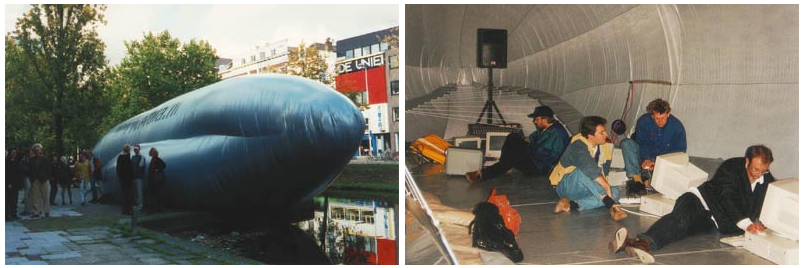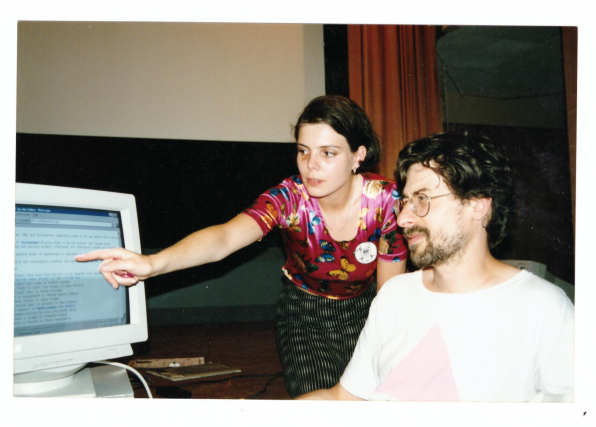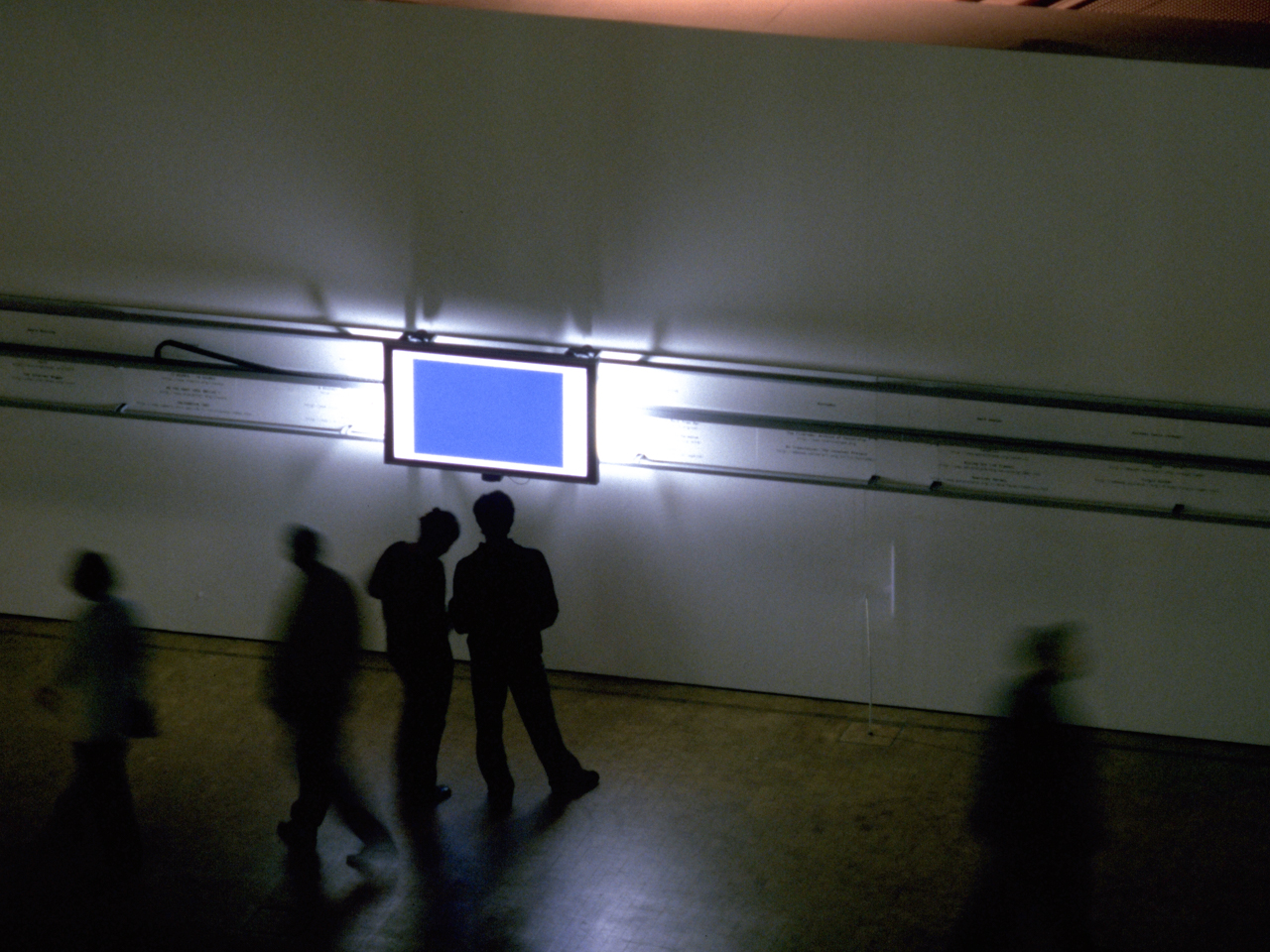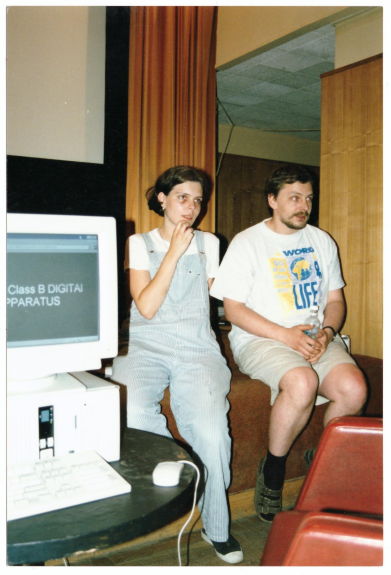This essay was first published in November 2000 in Du Magazine, and appears here in English for the first time. The essay has been translated into English from the original Russian by Alya Ponomareva.
Back when I ran a webpage about Russian “parallel cinema,” I got invited to a meeting of the Syndicate mailing list subscribers which was held in Rotterdam in September 1996, as part of the Dutch Electronic Art Festival (DEAF). When I registered at the festival, I got a badge that had “Artist” written on it. Before that, I considered myself mostly a film critic; I wrote about experimental cinema and served as a program director for CINE FANTOM film club. My career as an artist lasted the whole of three weeks. At the Metaforum III conference in Budapest, I presented a new web project, My Boyfriend Came Back from the War, and after that, I became a Famous Net Artist (FNA)—a fascinating and much-wanted profession.

ParaSITE inflatable internet cafe at DEAF, Rotterdam 1996.
I’d like to share four years’ worth of observations about the scene and talk about my personal experience of adapting to it.
CONFERENCES
For me, it all began with a conference, and my experience is not unique.
It runs contrary to the ideals of journalists who write about net art, but conferences do play an essential role in the lives of Famous Net Artists (FNAs). And if a net artist is an artist who creates online, an FNA is the same artist who speaks about her online work at international conferences.
A conference, by my definition, is any public event where an FNA stands before an audience with a computer in front of her and a big screen behind her that shows a projection of whatever she brings up on her display.
This happening could be a part of any other event: a film festival, a media exhibition, a book fair, etc. The organizers don’t necessarily have to refer to it as a “conference”.
Talking and presenting her work before an audience requires certain skills on part of an FNA. FNAs don’t use Power Point; they use browsers, which means that they have to be able to speak, click, and scroll at the same time. The rhythm of their presentation and the duration of their jokes should be adaptable to varying connection speeds and bandwidth limitations, and to the fact that any of these factors could change at any given moment.
Only an FNA who is a complete novice gets thrown for a loop when her internet connection suddenly stops working. And only a fake FNA could present her art from a disk or a CD, in a downloaded form, to shield herself from any potential failure.
Showing “internet” from a CD is like singing on stage to a pre-recorded voice track. Just like with singers, the audience never forgives this.
Conferences are the primary source of income (so far), a meeting space (usually), a starting point for this or that phase in the history of net art (incidentally).
Besides, conferences are the only way to do something interesting about net art offline.

Olia Lialina with Alexei Shulgin presenting will.teleportacia.org during the net art program at Cine Fantom Fest in June 1998. Photo: Vadim Epstein.
EXHIBITIONS
Exhibitions are a complete opposite. Net art exhibitions are the ugliest phenomenon of the modern art scene.
Although, due to the curators’ efforts, they might look different and even more or less unlike each other, any event that doesn’t classify as a conference and involves net art is what I call an Exhibition.
Instead of continuing to share my observations, allow me to go back to the source of my disgust, namely to the ideals and illusions that make exhibitions an unacceptable way to present her art for a Real Net Artist (RNA).
Net artists come from varying backgrounds. There are even some who used to be contemporary or media artists. Some are repentant video artists, photographers, or designers. In the current generation (for the sake of exactitude, I suggest a new abbreviation, RNA1), there are no artists who have worked with the online medium before they learned to read, write, and interact with others offline.
Despite their previous experience with creating and exhibiting their art in limited spaces, RNA1s work with the world wide global network and appeal to its users who are also spread across the entire globe.
Allow me to rephrase. An RNA1 knows all too well what it feels like when you create and exhibit art in a limited space, and for this very reason, she is especially averse to any attempts to bring her back there.
So: exhibitions. They, too, could be a part of any other event, from a film festival to a conference. They could be separate events, too. One of these—a huge one—was held a year ago at ZKM; it effectively put to rest any idea that any such undertaking could ever be a success.
What’s the reasoning behind exhibitions?
What lies behind them are illusions and greed for profit. Illusions are based on the idea that net art is no more than funny websites, something with just as much interactivity as a CD-ROM, only viewed in a browser and cooler-sounding.
As for greed for profit, it originated from idle talk that FNAs indulged in at conferences in the mid-90s: how a net art piece is not an exhibition object; how it transcends the walls of galleries and museums; how it belongs to everyone and can be experienced freely without intermediaries or entrance fees.
Okay, since it’s all so immaterial, it becomes all too easy for a curator of an “exhibition” to draft an event budget that includes nothing else but his organizer’s fee—the “scheme” is pretty simple.
The simpler it is and the easier it is to see through it, the less it hurts anyone.
There are also “lazy” exhibitions; these are marginally nicer and not as useless. Usually, an offline event announces that along with film, video, performance sections, etc., they are also going to have net art or web art (traditionally, no distinction is drawn between the two—but that’s not the point right now), after which they create a section on their website with links to chosen works of art.
In this case, the only thing that changes for the net art project is that someone puts up a new link to it online. The more links, the bigger the audience. Nothing wrong with that.
Notably, this practice has led to an emergence of a funny kind of reciprocity. An exhibition puts up a link to a project, and gets to include the FNA’s glorious name in its catalogue. And the FNA gets a chance to list the exhibition on her CV.
But where does the physical exhibition space come into play here? It doesn’t, of course. That’s why the “lazy” option has to be modified somehow. To connect the physical exhibition to what is happening online, the organizers put up a computer in the gallery or somewhere next to the entrance and open a browser window on it displaying the list of links mentioned above.
No one ever bothers to open them, of course. Someone might click on them once or twice, before they decide to check their mail or look up a weather report instead. It’s hard to get in the right mood. After all, people don’t usually go to galleries to read books—they don’t even go to book fairs to read books.
Anyway, it turns out that “lazy” exhibitions aren’t very popular. Even worse, the ordinary-looking computers with their mundane wires sticking out everywhere clash with the well-thought-out boxes and devices usually found at interactive exhibitions.
It seems like all of the above should inspire everyone to abandon the idea of exhibitions altogether and come to the same conclusions as I have in the first section: that the only possibility to bring the desired net art piece to the people who care to experience it in a public space is a “conference.” Only a living, smiling, proud FNA who comments and explains her own work can truly draw attention to it and engage the audience. The physical presence of an RNA1, competent and full of ideas, does infinitely more for the audience that wants to familiarize itself with the art of the future than any amount of links to her projects.
Despite all this, curators have never stopped inventing new ways to adapt net art to the existing and more or less working practices of engaging people who spend their idle time in galleries.
The results of their efforts can be roughly divided in two categories: the Object and the Zoo.
The Object is a prettied-up computer with a browser window open on the net artist’s page.
The prettying-up starts with sticking a plaque on the wall next to the computer that identifies it as a work of art, as befits an exhibition piece. As if it were possible to permanently tie the work to one concrete computer, or even protect the computer from being used by visitors to surf the web or check email.
The rest depends. To draw attention, computers can be placed in elaborate formations, upholstered with velvet, or put up on pedestals. It might make them look like set design pieces, or sometimes, like a monument to the triumph of the curator’s ideas over the artists’. Once, I saw a screen that moved back and forth across the wall and could be operated remotely, which symbolized—I’m not sure what exactly, but supposedly, you could use it to look at some web pages. The design made it completely impossible, but the photo of that breakthrough piece of technology got featured in every magazine article about that exhibition, just because it was visually appealing.

Jeffrey Shaw, The Net.Art Browser at "net_condition," ZKM, 1999-2000.
I heard that something similar happened to video art a decade or two ago: suddenly, the tapes as they were turned out not to be attractive enough for exhibitions, and artists started making video installations, moving farther and farther away from the visitors who sit and watch, and closer to the visitors who pass by.
I could draw a parallel with net art as exhibited in galleries, but it would be pointless. What we have here isn’t experimenting with language and form, it’s bending language and form to someone else’s will. A curator or an artist who makes an Object out of a net art piece removes it from its context and makes it look primitive. It becomes flat, and the more three-dimensional the object is, the more lifeless it seems.
When I talk about Objects, I don’t mean pieces created by media artists that use the internet in their real-life objects. There’s little I can say about those. I don’t often go to events featuring them, although several times, I have—I’ve taken part in Zoos.

openX zone at Ars Electronica in 1999. Photo: Sabine Starmayr.
A Zoo is a more expensive type of event that requires at least bringing the FNA to the location of the exhibition and accommodating her there. In the exhibition space, beside the usual computer with an inscription on the wall and an open browser, a chair is put down, and on that chair—oh, isn’t that great—sits the FNA in person. She whiles away her time checking her mail or debugging code for some RNA1. Just look at her, immersed in her mysterious work of creating net art. You can stand behind your idol’s back for a while, and if you’re brave enough, you can even ask her what net art is and if it’s true that it died last summer, as they say.
Big event organizers—Ars Electronica Center (AEC), for instance—really like setting up Zoos. I don’t really have any problems with it, other than considering it pointless.
Once, I witnessed an unexpected (or well-planned?) morphing of a Zoo into an Object. The computer that they gave me to spend my time around and showcase one of my projects was the first iMac imported into that particular country. As a result, everyone who entered the gallery instantly made a beeline for the computer, ignoring every other piece of art.
THE GALLERY
The observations on how net art fares in an alien territory that I have shared above aren’t very recent—they are two or three years old. Yet they remain current: little has changed in the relationship between online art pieces and the ways they are presented offline (the only difference is that the nonsensical attempts to demonstrate net projects on computers not connected to the internet have finally stopped). But since 1998, a certain boredom has set in.
RNA1s produced art projects, one more radical than the other, and went out to Conferences where they spoke about their independence from offline art institutions—while getting paid by them. Or, they sat in Zoos. Or, they made fun of Objects.
Back then, I wrote an article, in broken and angry English, that I named “Cheap.art”—its gist was that we should stop turning ourselves into a cheap commodity for old institutions. Rather than force ourselves to project enthusiasm, we should try coming out with a new infrastructure.
What if instead of exporting artworks and ideas into the offline world, we tried to import the artist-gallery-audience dynamic online, together with any monetary exchanges that might flow out of it?
That’s when the First Real Net Art Gallery, named Art.Teleportacia (art.teleportacia.org), came into being. It’s a place online (currently, one of several; two years ago, the principal one) where you can buy pieces of net art to decorate your electronic office or home page. Business people buy paintings to decorate their offices—why wouldn’t they consider embellishing their representative pages on the global network? Such was my logic back in July 1998.
I used the ambitious “First Real” prefix to once and forever separate this gallery from thousands of other Net Art Galleries, named this way ages ago but containing something completely opposite to true net art. Usually, these galleries feature official and private pages of painters, photographers, woodcutters, etc. They publish photographs of their art, using the web to the full extent as an electronic catalogue. I won’t be surprised to find out that some people out there still consider this kind of presentation material “net art.”
The gallery opened with an exhibition called “Miniatures of Heroic Period.” It featured small-scale artworks by five RNA1s, each accompanied by a specially commissioned article written by a net art critic. The critics, who were used to writing about how being not for sale was in the very nature of net art, had this time to explain why this or that piece could become a perfect investment and a source of collector’s pride.
To this day, Art.Teleportacia haven’t yet become the “money machine”. In a year after its opening, I’ve only managed to sell one piece of art—unfortunately, it was one of my own. And since it was bought by a friendly site, entropy8zuper.org, I took it (perhaps unjustly) as a purely artistic gesture.
When I started the gallery, I made an attempt to imitate an exhibition space online and combined it with a conventional interface of an internet store. Several weeks later, I found out that every section of the gallery site, including the “office,” the order form and the entrance page, have turned into a forum where visitors discuss net art sales, strategies and tactics of collecting, and the made-up issue of original vs. copied art.
With its commercial ambitions squashed, Art.Teleportacia has turned into a gallery-yet-to-be. It’s become a repository of discussions that take place before things finally settle and buying and selling net art turns into a boring, routine thing.
The years 1999-2000 have seen a surge of interest for net art online on the part of big museums. We’ve seen expensive online exhibitions, projects and grants. The $50,000 internet art award established by SFMOMA makes it very clear: the museums are now taking net artists as seriously as possible.
A web-based magazine, Rhizome, has started working on ArtBase, an archive of net art. For now, it looks pretty basic, but among media curators and art theoreticians on its advisory board, passions run high. They represent competing organizations, but finding a recipe for conserving net art and transforming it into museum objects is everyone’s top priority.
The Art.Teleportacia project caught the attention of modern art museum curators. They have a lot of experience storing slides, video art, and CDs in their archives. But what do you do with internet art? How do you own it? How do you make it part of your collection if you can’t put it on a shelf?
Things would have been much easier if net art could be reduced to web art—that is, nothing more than hypertext pages with funny animations and experiments exploring the technical capabilities of browser software (very few interesting projects can be actually described this way). If this were the case, the buyer could simply move the art to his server. But how do you treat art that explores the path that the user takes after viewing a certain page or pages (which don’t even have to be located on the same server), the journey that’s beyond the artist’s control?
Internet art resolutely defies any attempts to possess it. The old notions of property no longer apply here—in fact, none of the old notions apply. But new notions are starting to emerge, and it’s not too late to help shape them. Rather than deal with hypotheticals or draw analogies with existing practices, we should base our understanding on concrete examples, details, and practical cases.
I suggest that we start with secondary matters.
For instance, what do we do with a project’s feedback email address after the artist has sold it or after it’s been placed in an archive? This is a problem that we’re investigating right now on the gallery’s main page. It’s great how the different answers provoke new questions that reveal the nature of internet art pieces.
 Olia Lialina and Eugene Gorny during the net art program at Cine Fantom Fest in June 1998. Photo: Vadim Epstein.
Olia Lialina and Eugene Gorny during the net art program at Cine Fantom Fest in June 1998. Photo: Vadim Epstein.
Or, yet another important detail: the address bar.
Observing what galleries and museums do online, I’ve noticed that curators came up with a workaround to compensate for the fact that they cannot transfer the artwork they want to feature to their own servers. What they do is use links that open in a new browser window with the location bar switched off. The URL, the original address of the project, together with the names of folders and files, disappears. This way, they create an illusion that the work belongs to them. It doesn’t really qualify as theft. You can even argue that it’s being done for aesthetic reasons—so that technical details won’t distract the viewer from the contents of the main window.
The problem is that what happens in the location bar is no less important than the text and the graphics. The address bar is the author’s signature. It’s where action takes place, and it’s the action itself. The real action on the web doesn’t happen on the page with its animated GIFs or funny scripts, it’s concentrated in the address bar.
To prove it, in September 1999 I opened an educational exhibition in Art.Teleportacia called “Location=Yes” (art.teleportacia.org/Location_Yes). It features projects (including non-artistic ones) that place the emphasis on the URL. Unusual or significant domain names, animated address bars or those that feature dialogue prompts, formalistic or baroque URLs. Each object is provided with a commentary. The exhibition is constantly expanding.
By the way, curating shows online brings a pleasure never experienced before: that of a freedom from either space or time constraints. There’s no need to remove an art project from your gallery by a certain date because there’s another one waiting for its turn—there’s enough room for everyone. Moreover, you can keep updating and changing an online exhibition for as long as you like. I’d even go as far as to say that this is the only right way to do it, but it will take us a little while longer to get used to this new way of doing things.
And finally—backlinking! A simple thing that people somehow forget about.
Heath Bunting, a British RNA1, handed his innovative solution titled Donate Net.Art over to Art.Teleportacia. The service offers the artists an opportunity to donate their works to large museums and art centers. After they fill out a legally faultless form, their offer lands in the inbox of a person who curates the organization’s internet projects. The service has existed for over a year, and I’m proud (and sorry) to say that Art.Teleportacia is the only organization that links back to the donated projects.
THE MUSEUM
This March I took the experiment further by opening the First Real Net Art Museum (myboyfriendcamebackfromth.ewar.ru)—a hall of fame dedicated to my first project, My Boyfriend Came Back From the War. The collection features ten interpretations of the 1996 project by different artists utilizing different genres and technologies—copy, remix, Flash, audio, banner, action alert, VRML, txt, video. Some versions are already getting more hits than the original.
The museum also has an archive of meticulously collected materials that are in any way related to MBCBFTW. It was originally conceived as a parody on what museum workers usually do, but I got carried away.
There’s also a shop selling MBCBFTW t-shirts.
The First Real prefix lasted less than a day. As soon as I sent out the announcement, I got several skeptical replies pointing out that I was headed down a well-beaten path. Embarrassed as I was, I had to agree.
The museum was instantly renamed into Last Real Net Art Museum. This hits closer to the mark. What I really wanted wasn’t to say a new word but to draw attention to something that could disappear.
Things have gotten so serious now. Everything is done on such a grand scale that we’ll hardly see any more projects where an artist is her own curator, her own promoter, her own museum and art critic. (Note that I’m writing this article myself now).
I really doubt that anyone still considers going without Flash interstitials or other web performances when designing such an aesthetically important object as a museum. The Last Real Net Art Museum has a grey background, black text, dark blue links and red active links. I think this is the best way to emphasize what’s really important.
And what’s really important is that the coming generation of net museum curators has no plans to base their exhibitions and archives on links spread across the entire internet. There’s a reason why I asked artists to keep the versions of MBCBFTW running from their own servers. I think it’s important for those participating artists to be able to make changes to their work or simply destroy it.
That is, as long as they aren’t fed up with it—or the idea behind it.
Header image: Joan Heemskerk, Olia Lialina, Rasa Smite at the Last Real Net Art Museum house party in Moscow, May 2000. Photo: Frederic Madre


